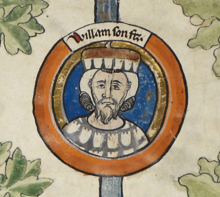|
William Longsword
William Longsword (French: Guillaume Longue-Épée, Old Norman: Williame de lon Espee, Latin: Willermus Longa Spata, Old Norse: Vilhjálmr Langaspjót; c. 893 – 17 December 942) was the second ruler of Normandy, from 927 until his assassination in 942.[1] He is sometimes referred to as a "duke of Normandy", though the title duke (dux) did not come into common usage until the 11th century.[2] Longsword was known at the time as count (Latin comes) of Rouen.[3][4] Flodoard—always detailed about titles—consistently referred to both Rollo and his son William as principes (chieftains) of the Normans.[5] There are no contemporary accounts of William's byname, 'Longsword', either; it appears first in later eleventh-century sources.[6] BirthWilliam Longsword was born "overseas"[a][7] to the Viking Rollo (while he was still a pagan) and his wife more danico (a kind of non-Christian marriage), Poppa of Bayeux.[8][9][10] Poppa's parentage is uncertain.[11] Dudo of Saint-Quentin in his panegyric of the Norman dukes describes her as the daughter of a Count Berengar, the dominant prince of that region.[12] In the 11th-century Annales Rotomagenses (Annals of Rouen),[13] she is called the daughter of Guy, Count of Senlis,[14] otherwise unknown to history.[b] According to the Longsword's planctus, William was baptized a Christian probably at the same time as his father,[15] which Orderic Vitalis stated was in 912, by Franco, Archbishop of Rouen.[16] Life The funerary monument of William Longsword in the cathedral of Rouen, France. The monument is from the 14th century. William succeeded Rollo (who continued to live about five more years) in 927[17] and, early in his reign, in 933, faced a rebellion from Normans[18] who felt he had become too Gallicised.[19] According to Orderic Vitalis, the leader of the rebellion was Riouf of Evreux,[19][20][21] who besieged William in Rouen. Sallying forth, William won a decisive battle, proving his authority to be duke.[22]: 25–6 At the time of this rebellion, William sent his pregnant wife more danico, Sprota, to Fécamp where their son Richard was born.[23] In 933, William recognized King Raoul, who was struggling to assert his authority in Northern France, as King of Western Francia. In turn, Raoul gave him lordship over much of the lands of the Bretons including Avranches, the Cotentin Peninsula and the Channel Islands.[24][25][26]: lii The Bretons resisted these changes, led by Alan II, Duke of Brittany, and Count Berengar of Rennes, but this ended shortly with great slaughter and Breton castles being razed to the ground;[22]: 24 Alan fled to England and Berengar sought reconciliation.[27] In 935, William married Luitgarde,[1] daughter of Count Herbert II of Vermandois, whose dowry gave him the lands of Longueville, Coudres and Illiers-l'Évêque.[21] He also contracted a marriage between his sister Adela (whose Norse name was Gerloc) and William, Count of Poitou, with the approval of France's most powerful magnate, Hugh the Great.[28] In addition to supporting King Raoul, William was now a loyal ally of his father-in-law, Herbert II, both of whom his father had opposed.[29] In January 936, Raoul died and the 16-year-old Louis IV, who was living in exile in England, was persuaded by a promise of loyalty by William to return and became king. The Bretons returned from exile seeking to recover the lands taken by the Normans, resulting in fighting in the expanded Norman lands.[26]: lii The new king was not capable of controlling his Barons and, after William's brother-in-law, Herluin II, Count of Montreuil, was attacked by Flanders, William went to their assistance in 939,[22]: 28–9 whereupon Arnulf I, Count of Flanders retaliated by attacking Normandy. Arnulf captured the castle of Montreuil-sur-Mer, expelling Herluin, after which Herluin and William cooperated to retake the castle.[30][31] William was excommunicated for his actions in destroying several estates belonging to Arnulf.[32] William pledged his loyalty to King Louis IV when they met in 940 and, in return, he was confirmed in lands that had been given to his father.[26]: liii [33] AssassinationIn 941, a peace treaty, brokered in Rouen by King Louis IV, was signed between the Bretons and Normans, which limited Norman expansion into Breton lands.[26]: liii The following year, on 17 December 942 at Picquigny on an island on the Somme, William was ambushed and killed by followers of Arnulf while at a peace conference to settle their differences.[21][31] FamilyWilliam had no children with his Christian wife, Luitgarde.[34] He fathered a son, Richard, with Sprota,[c] his wife more danico.[35] Richard, then aged 10, succeeded as ruler of Normandy upon William's death in December, 942.[34] Notes
References
External links |
||||||||||||||||||||||||||||||
